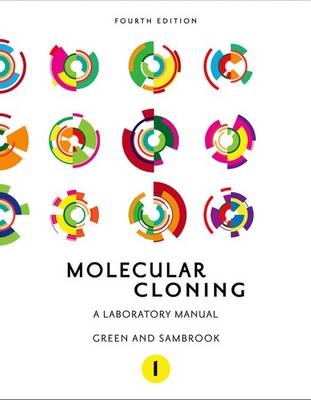
Molecular Cloning
Cold Spring Harbor Laboratory Press (Verlag)
978-1-936113-42-2 (ISBN)
- Titel z.Zt. nicht lieferbar
- Versandkostenfrei innerhalb Deutschlands
- Auch auf Rechnung
- Verfügbarkeit in der Filiale vor Ort prüfen
- Artikel merken
For the fourth edition of this classic work, the content has been entirely recast to include nucleic-acid based methods selected as the most widely used and valuable in molecular and cellular biology laboratories.
Core chapters from the third edition have been revised to feature current strategies and approaches to the preparation and cloning of nucleic acids, gene transfer, and expression analysis. They are augmented by 12 new chapters which show how DNA, RNA, and proteins should be prepared, evaluated, and manipulated, and how data generation and analysis can be handled.
The new content includes methods for studying interactions between cellular components, such as microarrays, next-generation sequencing technologies, RNA interference, and epigenetic analysis using DNA methylation techniques and chromatin immunoprecipitation. To make sense of the wealth of data produced by these techniques, a bioinformatics chapter describes the use of analytical tools for comparing sequences of genes and proteins and identifying common expression patterns among sets of genes.
Building on thirty years of trust, reliability, and authority, the fourth edition of Molecular Cloning is the new gold standard—the one indispensable molecular biology laboratory manual and reference source.
Highlights of the new edition:
- Extensive new content: 12 entirely new chapters are devoted to the most exciting current research strategies, including epigenetic analysis, RNA interference, genome sequencing, and bioinformatics
- Expanded scope: the nucleic-acid-based techniques selected for inclusion have promoted recent advances in gene transfer, protein expression, RNA analysis, and expression of cloned genes
- Classic content: 10 original core chapters have been updated to reflect developments and innovations in standard techniques and to introduce new cutting-edge protocols
- Easy-to-follow format: the previous editions’ renowned attention to detail and accuracy are fully retained
- Essential appendices: an up-to-date collection of reagents, vectors, media, detection systems, and commonly used techniques are included
- Expanded authorship: chapters and protocols have been specifically commissioned from renowned experts at leading institutions
VOLUME 1
Part 1: Essentials
1. Isolation and Quantification of DNA
2. Analysis of DNA
3. Cloning and Transformation with Plasmid Vectors
4. Gateway Recombinational Cloning
John S. Reece-Hoyes and Albertha J.M. Walhout
5. Working with Bacterial Artificial Chromosomes and Other High-Capacity Vectors
Nathaniel Heintz and Shiaoching Gong
6. Extraction, Purification, and Analysis of RNA from Eukaryotic Cells
7. Polymerase Chain Reaction
8. Bioinformatics
Jui-Hung Hung and Zhiping Weng
VOLUME 2
Part 2: Analysis and Manipulation of DNA and RNA
9. Quantification of DNA and RNA by Real-Time Polymerase Chain Reaction
10. Nucleic Acid Platform Technologies
Oliver Rando
11. DNA Sequencing
Elaine Mardis and W. Richard McCombie
12. Analysis of DNA Methylation in Mammalian Cells
Paul M. Lizardi, Qin Yan, and Narendra Wajapeyee
13. Preparation of Labeled DNA, RNA, and Oligonucleotide Probes
14. Methods for In Vitro Mutagenesis
Matteo Forloni, Alex Liu, and Narendra Wajapeyee
Part 3: Introducing Genes into Cells
15. Introducing Genes into Cultured Mammalian Cells
Priti Kumar, Arvindhan Nagarajan, and Pradeep D. Uchil
16. Introducing Genes into Mammalian Cells: Viral Vectors
Guangping Gao and Miguel Sena-Esteves
VOLUME 3
Part 4: Gene Expression
17. Analysis of Gene Regulation Using Reporter Systems
Pradeep D. Uchil, Arvindhan Nagarajan, and Priti Kumar
18. RNA Interference and Small RNA Analysis
Chengjian Li and Phillip D. Zamore
19. Expressing Cloned Genes for Protein Production, Purification, and Analysis
Clara L. Kielkopf, William Bauer, and Ina Urbatsch
Part 5: Interaction Analysis
20. Cross-Linking Technologies for Analysis of Chromatin Structure and Function
Tae Hoon Kim and Job Dekker
21. Mapping of In Vivo RNA-Binding Sites by UV-Cross-Linking Immunoprecipitation (CLIP)
Jennifer C. Darnell, Aldo Mele, Ka Ying Sharon Hung, and Robert B. Darnell
22. Gateway-Compatible Yeast One-Hybrid and Two-Hybrid Assays
John S. Reece-Hoyes and Albertha J.M. Walhout
Appendices
1. Reagents and Buffers
2. Commonly Used Techniques
3. Detection Systems
4. General Safety and Hazardous Material
Index
In science...speed matters and credibility matters. And compared to banking on...an anonymous contributor in an online discussion group, you’d be better off trusting Michael Green and Joseph Sambrook. When skimming through the pages of Molecular Cloning, it is impossible not to gain new insights that will push your experiments forward.
— Lab Times
Any basic research laboratory using molecular biology techniques will benefit from having a copy on hand of the newly published Third Edition of Molecular Cloning: A Laboratory Manual...the first two editions of this book have been staples of molecular biology with a proven reputation for accuracy and thoroughness.
— The Scientist on the previous edition
Molecular Cloning: A Laboratory Manual has always been the laboratory mainstay for protocols and techniques. It has a pure-bred ancestry, and the new edition does not disappoint. (It) includes information panels at the end of each chapter that describe the principles behind the protocols.... The addition of this information extends Molecular Cloning from an essential laboratory resource into a new realm, one merging the previous prototype with a modern molecular monograph...the next generation of Molecular Cloning not only carries on the proud heritage of the first two editions but also admirably expands on that tradition to provide a truly essential laboratory manual.
— Trends in Microbiology on the previous edition
In every kitchen there is at least one indispensable cookbook...Molecular Cloning: A Laboratory Manual fills the same niche in the laboratory (with) information to help both the inexperienced and the advanced user. (It) has once again established its primacy as the molecular laboratory manual and is likely to be found on lab benches...around the world.
— Trends in Neurosciences on the previous edition
| Erscheint lt. Verlag | 1.7.2012 |
|---|---|
| Zusatzinfo | illustrations |
| Verlagsort | New York |
| Sprache | englisch |
| Maße | 234 x 284 mm |
| Gewicht | 5919 g |
| Einbandart | kartoniert |
| Themenwelt | Naturwissenschaften ► Biologie ► Biochemie |
| Naturwissenschaften ► Biologie ► Genetik / Molekularbiologie | |
| Schlagworte | Genetik • Klonen • Molekularbiologie |
| ISBN-10 | 1-936113-42-2 / 1936113422 |
| ISBN-13 | 978-1-936113-42-2 / 9781936113422 |
| Zustand | Neuware |
| Informationen gemäß Produktsicherheitsverordnung (GPSR) | |
| Haben Sie eine Frage zum Produkt? |
aus dem Bereich


